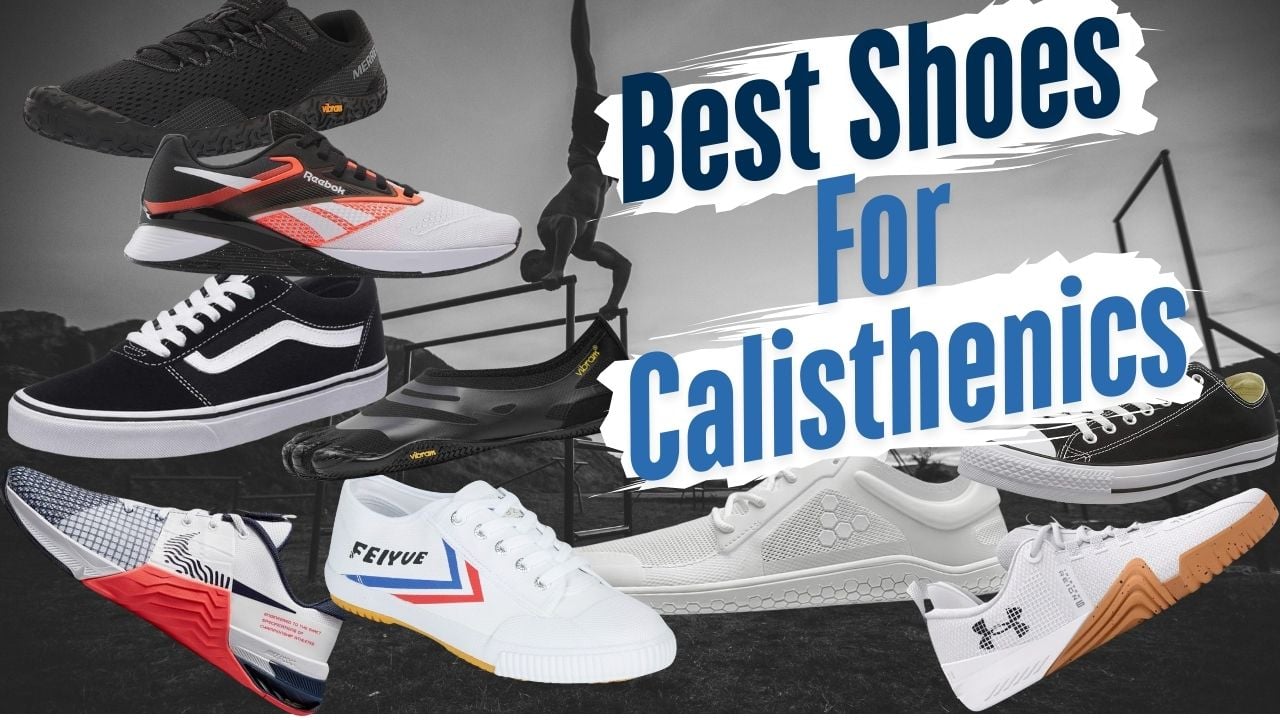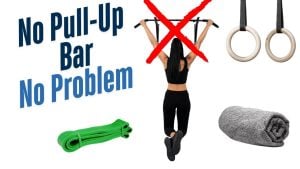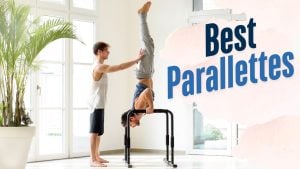If you’re serious about calisthenics or functional strength training, you already know that the wrong pair of shoes can mess up your entire session. I’ve personally tested all the shoes in this list—across handstands, muscle-ups, ring dips, pistol squats, weighted calisthenics, and even the occasional barbell squat and deadlift.
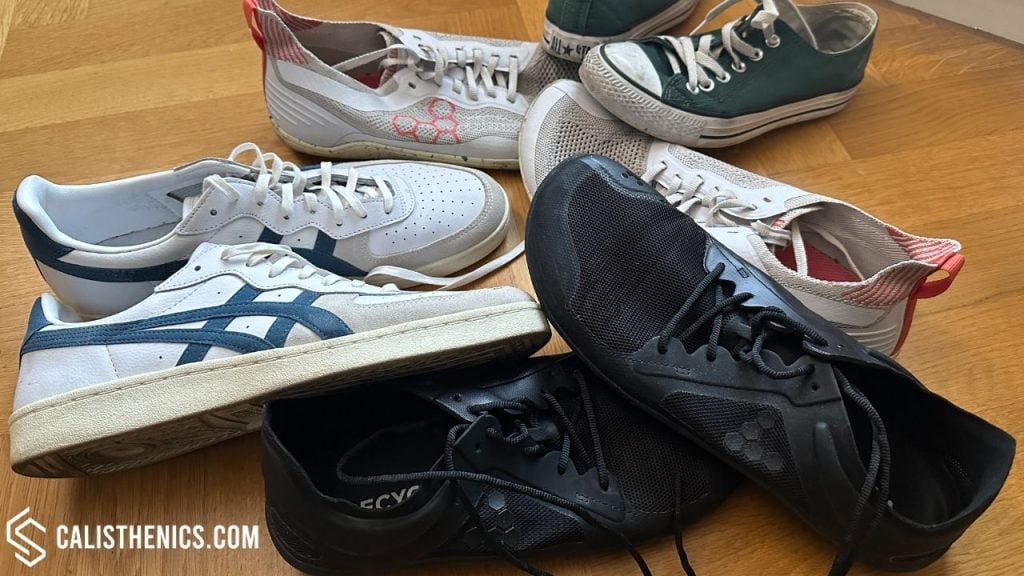
In this post, I’ll walk you through my real-world experience with each of them. I’ve judged every shoe based on the criteria that actually matter for our kind of training: stability, breathability, comfort and fit, grip, weight, and durability. Whether you’re training on a pull-up bar, dipping on rings, jumping into burpees, or just walking to the park, there’s a shoe on this list for you.
That said, whenever I’m training at home or in a hotel room, I actually prefer to train barefoot — and you’ll see that clearly in the exercise library, where I demo most movements in my signature white Nike socks. Training without shoes helps me stay connected to the ground, improve my foot mechanics, and build balance from the ground up. Still, shoes are essential when I’m training outdoors, in the gym, or adding external load — and that’s exactly where this list comes in.
Let’s kick things off with my absolute favorite for pure bodyweight training: the Vivobarefoot Primus Lite 3.
Vivobarefoot Primus Lite 3 — My Top Pick for Calisthenics
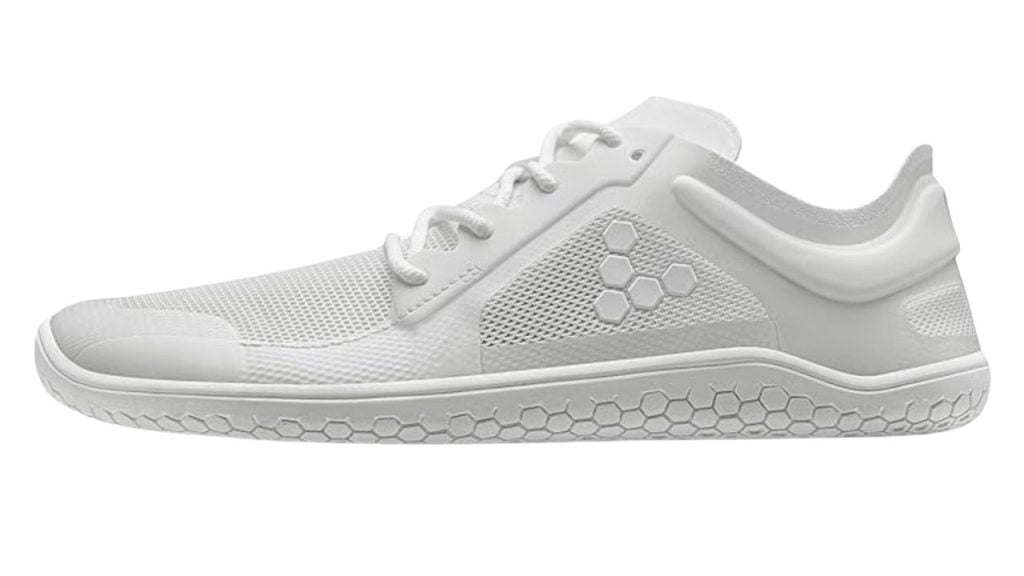
If I had to choose just one shoe for calisthenics, this would be it. The Primus Lite 3 gives me the barefoot freedom I love, while still providing just enough structure to keep things stable during explosive movements like jump squats or lunges. Whether I’m practicing the human flag, doing single-leg squats, or flowing through a mobility circuit, these feel like an extension of my foot. There’s something about the ground connection you get with these that just isn’t possible in more cushioned or structured shoes.
Over time, I’ve noticed that wearing the Primus Lite 3 has improved my foot awareness, balance, and even my posture during static holds and transitions. The wide toe box lets my toes spread naturally, which helps a lot with stability in moves like pistol squats or L-sits. Breathability is excellent — I never feel like my feet are overheating, even during longer workouts in warmer weather. However, I wouldn’t wear these for heavy barbell lifts or extended walks on pavement. They’re super minimal, and while that’s great for proprioception and mobility, they don’t offer much in the way of shock absorption or support for weighted work.
Durability-wise, they’ve held up better than I expected for such a light and flexible shoe. The upper mesh is thin but resilient, and the sole hasn’t worn down much despite regular use on concrete, gym mats, and wooden floors. That said, they’re on the pricier side — and if you’re not used to minimalist footwear, there’s definitely an adaptation period. Your calves and feet will work a bit harder at first. But once your body adjusts, it’s hard to go back. For calisthenics purists, movement nerds, or anyone who values barefoot training, I can’t recommend them enough.
🔍 Fact Sheet
- Drop: Zero drop (completely flat sole)
- Stack Height: Ultra-thin (4mm sole)
- Weight: ~200g (size-dependent)
- Upper Material: Breathable mesh with some recycled content
- Outsole: Thin, puncture-resistant rubber with excellent ground feel
- Toe Box: Wide for natural toe splay
- Flexibility: Very high — easily rollable
- Best Use: Bodyweight training, barefoot-style workouts, mobility work
✅ Pros
- Incredible ground feel for balance-heavy exercises
- Wide toe box supports natural movement
- Lightweight and breathable
- Stylish enough for casual wear
- Eco-friendly materials
❌ Cons
- Minimal cushioning—not great for running or jumping on concrete
- Expensive compared to other minimalist shoes
- Not suitable for heavy lifting or extended walking sessions
👉 Check customer reviews for Vivibarefoot and buy on Amazon
Nike Metcon 9 — Built for Stability Under Load
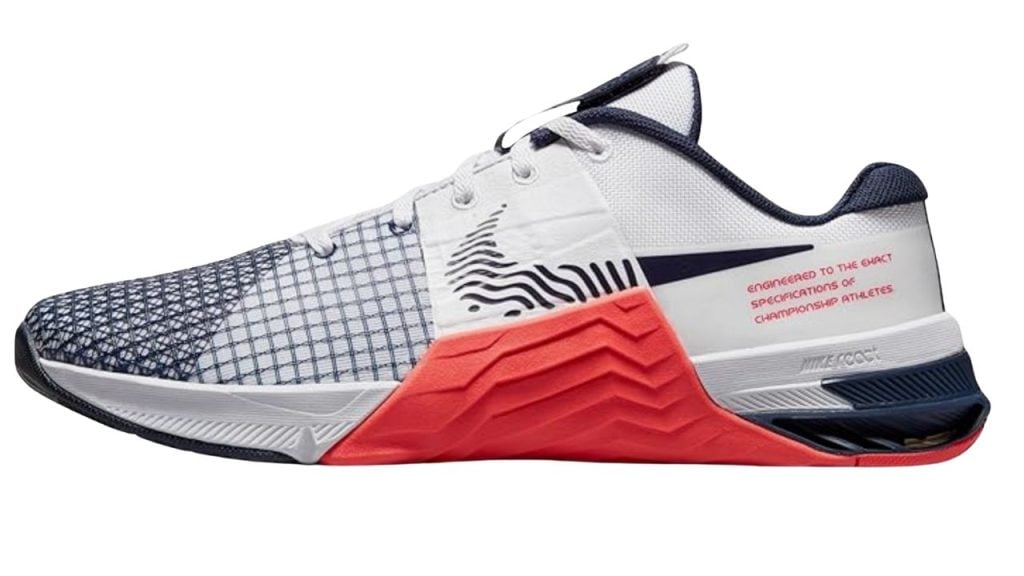
While the Vivobarefoots are my go-to for bodyweight workouts, the Nike Metcon 9 is what I lace up when I’m incorporating more weighted exercises into my routine — especially for heavy squats, loaded carries, or kettlebell complexes. The solid heel and wide, rigid base give a locked-in feel that’s incredibly reassuring under load. I don’t get any wobble or give in the sole, which is exactly what I want when I’m doing barbell squats or Bulgarian split squats with weight.
One of the things I noticed right away was how well the Metcon 9 blends structure with comfort. The upper is snug and supportive without feeling restrictive, and the cushioning is just enough to absorb some impact without compromising ground connection. That said, these shoes are noticeably heavier and bulkier than minimalist options like the Primus Lite or Merrell Vapour Glove. For dynamic bodyweight movements or mobility flows, they’re not ideal — but for high-intensity circuits that include burpees, sled pushes, or dumbbell thrusters, they’re perfect. I also reach for them when I know I’ll be on my feet longer, walking or coaching, because they offer more support than barefoot shoes.
Durability is a strong point with the Metcon 9s. The outsole grips well on gym floors, concrete, and rubber mats, and the overall build quality feels premium. After several months of wear, mine still look and perform like new. They’re a bit overkill for pure calisthenics, but if you’re hybrid training — mixing bodyweight work with lifting — or just want something with serious support for leg day, they’re hard to beat.
🔍 Fact Sheet
- Drop: 4mm
- Weight: ~350–400g (depending on size)
- Upper Material: Reinforced mesh with rope wrap and side overlays
- Outsole: Durable rubber with great traction and a wide heel base
- Heel: Rigid plastic insert for stability under heavy loads
- Best Use: Cross-training, weightlifting, functional strength training
✅ Pros
- Incredibly stable under load — great for squats and Olympic lifts
- Durable materials built to handle abrasion and friction
- Supportive upper with solid lockdown feel
- Great grip on all common gym surfaces
- Ideal for hybrid calisthenics + strength training sessions
❌ Cons
- Too stiff and heavy for mobility drills or barefoot-style movement
- Less ground feel than minimalist shoes
- Can feel bulky for fast-paced bodyweight workouts
👉 Check customer reviews for Nike Metcons and buy on Amazon
Reebok Nano X4 — Stable, Breathable, and Surprisingly Comfortable
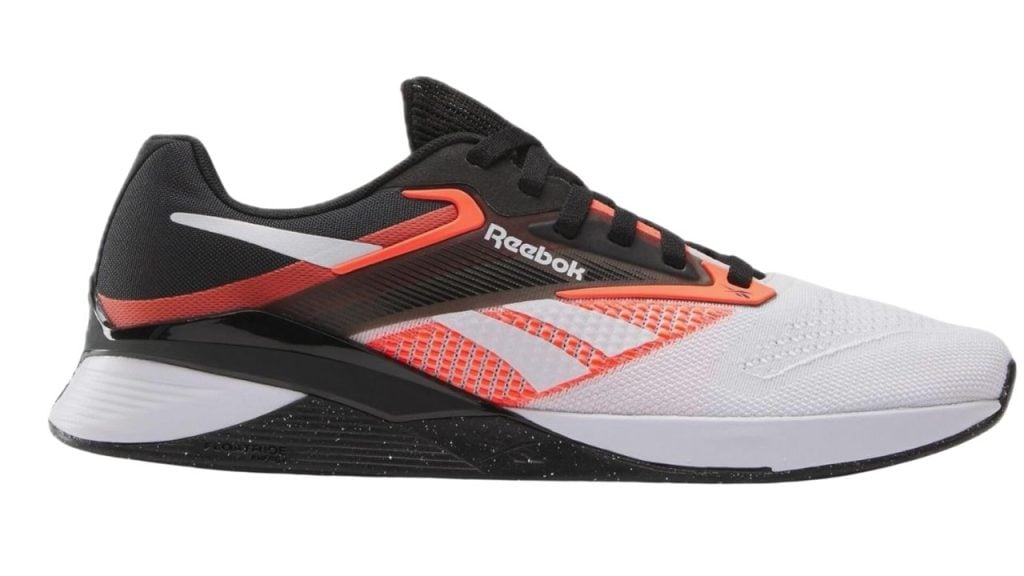
The Reebok Nano X4 strikes a really nice balance between structure and flexibility. It’s one of my favorite all-rounders for hybrid sessions — think weighted lunges, ring rows, handstand work, and even a light jog warm-up. If I know I’m doing a mix of calisthenics with some loaded exercises like goblet squats or sandbag carries, these are a solid choice. They’re slightly less stiff than the Nike Metcons, which makes them feel more versatile and comfortable for longer sessions or casual wear.
What I really appreciate about the Nano X4 is how breathable and light they feel for a cross-training shoe. The upper uses a new Flexweave knit material that keeps my feet cool, even in high-rep, high-sweat workouts. The heel is firm and stable for squats, but the forefoot still has some flex, which I find makes push-ups, planks, and dynamic bodyweight movements more natural. Compared to older Nano versions, the X4 feels more refined — the lockdown is better, the fit is more dialed in, and there’s less of that clunky “brick” feeling that earlier models had.
If I had to nitpick, I’d say the arch is a little more pronounced than I usually like — especially coming from barefoot shoes — but it hasn’t caused any discomfort. I’ve worn these for long walks and even full days out, and my feet felt good the whole time. In terms of durability, the Nano X4 is holding up great. The rubber outsole is grippy and doesn’t show much wear, and the upper has handled gym friction without fraying. If you’re looking for one shoe that can handle strength work, calisthenics, and conditioning circuits, this is a fantastic option.
🔍 Fact Sheet
- Drop: 7mm
- Weight: ~320g (varies by size)
- Upper Material: Flexweave knit (lightweight, breathable, durable)
- Outsole: High-traction rubber with reinforced sidewalls
- Heel: Lift-friendly stable platform with a moderate drop
- Best Use: Cross-training, bodyweight + weighted workouts, everyday gym use
✅ Pros
- Versatile enough for calisthenics, lifting, and light running
- More flexible than other weightlifting shoes like the Metcon
- Breathable upper keeps feet cool during longer sessions
- Comfortable enough for all-day wear
- Great stability for weighted squats and deadlifts
❌ Cons
- Not as lightweight or minimal as barefoot-style shoes
- 7mm drop may feel high for some calisthenics purists
- Slightly bulky for explosive footwork or deep mobility work
👉 Check customer reviews for Reebok Nano and buy on Amazon
Merrell Vapor Glove 6 — Featherlight and Ultra-Minimalist
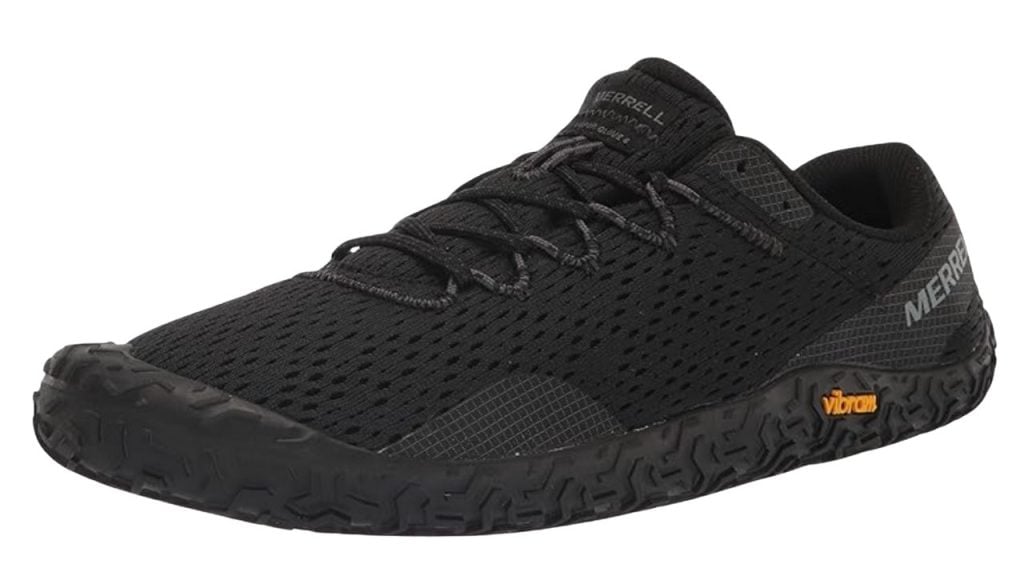
If you’re after that raw, barefoot feel but want something a little more affordable or casual-looking than the Vivobarefoot Primus Lite 3, the Merrell Vapor Glove 6 is an excellent pick. These shoes are ultra minimalist — just a thin rubber sole between you and the ground, with an upper that feels more like a sock than a shoe. I’ve used them for everything from mobility flows and balance drills to core circuits and light leg days, and they’re fantastic for building foot strength and improving proprioception.
The ground feel in the Vapor Glove is outstanding. I can feel every shift in weight during single-leg movements and handstand holds, which really helps with control and alignment. Compared to the Vivobarefoot shoes, they’re even lighter and more flexible, though the build quality doesn’t feel quite as premium. That said, the outsole still offers decent protection against sharp objects or rough terrain — I’ve worn them outdoors on grass, gravel, and asphalt without any real discomfort.
Where the Vapor Gloves fall short is in durability and support. These aren’t the shoes I’d choose for anything weighted. Even moderate resistance band training can make the sole feel a bit too thin under pressure. The upper material is also prone to wear and tear over time, especially if you use them frequently on abrasive surfaces. But for pure bodyweight training, stretching, and light park workouts, they’re great — especially if you want to ease into barefoot training without dropping a lot of money.
🔍 Fact Sheet
- Drop: Zero drop
- Stack Height: Approx. 6mm (including outsole and insole)
- Weight: ~150–180g (extremely light)
- Upper Material: Lightweight mesh and TPU
- Outsole: Vibram® EcoStep for grip and flexibility
- Toe Box: Wide for natural toe splay
- Best Use: Barefoot-style calisthenics, mobility, low-impact outdoor training
✅ Pros
- One of the most barefoot-feeling shoes on the market
- Very lightweight and flexible
- Excellent ground feedback and foot articulation
- Grippy outsole works well indoors and outdoors
- Affordable compared to other minimalist shoes
❌ Cons
- Not suitable for weighted or high-impact training
- Thin upper may wear out with frequent use
- Less structured fit than competitors like Vivobarefoot
👉 Check customer reviews for Merrell Vapor and buy on Amazon
Vibram FiveFingers — Barefoot Training, Toe by Toe
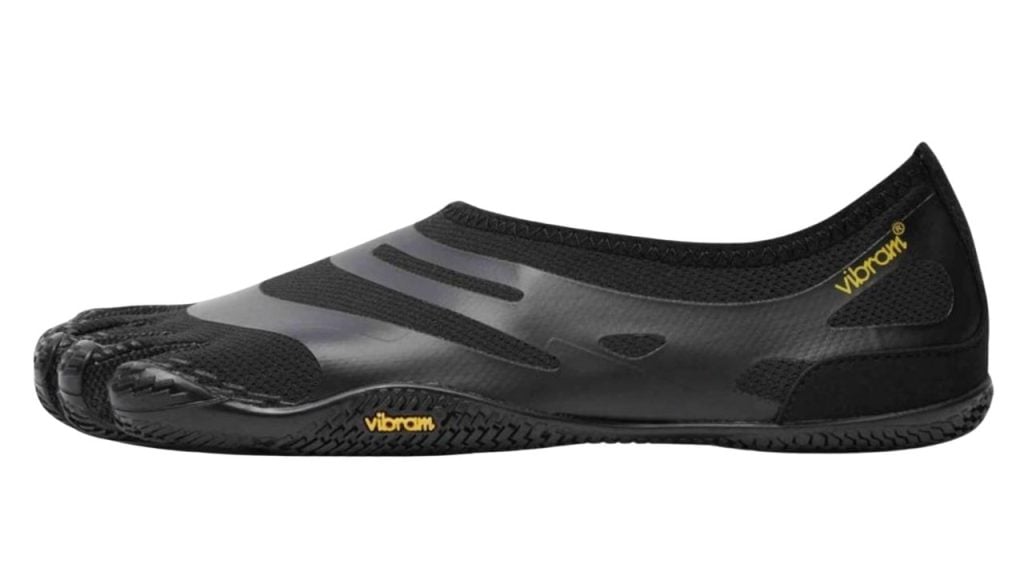
Wearing the Vibram FiveFingers for the first time felt like slipping into a glove for my foot — and honestly, it took a few sessions before I fully adjusted. But once I did, these shoes gave me some of the most precise control I’ve ever felt during bodyweight training. Each toe moves independently, which enhances balance and stability in ways that even other barefoot shoes don’t replicate. For exercises like single-leg RDLs, pistol squats, and even explosive moves like tuck jumps, the ground feedback and articulation are exceptional.
Where these really shine is in training sessions where precision and control matter most. Think static holds, gymnastic skill work, and low-impact flow sequences. I often wear them for handstand practice or parallette work when I want as little material as possible between me and the floor. They’re also great for outdoor training — the Vibram outsole grips exceptionally well on natural surfaces, and they dry quickly if I’m caught in the rain. They feel a bit tighter than something like the Merrell Vapor Glove or Primus Lite, but once broken in, they mold to your foot like a second skin.
That said, they’re definitely not for everyone. The individual toe pockets can feel awkward at first, and they’re not the easiest shoes to put on quickly. Plus, while they’re durable for minimalist training, I wouldn’t recommend them for high-rep workouts involving dragging movements (like sled work) or abrasive indoor flooring. And let’s be honest — they’re not exactly a fashion statement. But for purists who love barefoot calisthenics or want to strengthen their feet in a truly minimalist way, they’re hard to beat.
🔍 Fact Sheet
- Drop: Zero drop
- Stack Height: Varies slightly by model (~3–5mm total)
- Weight: ~150g (ultra-light)
- Upper Material: Stretch mesh or polyester (depending on model)
- Outsole: Vibram XS Trek for grip and flexibility
- Toe Box: Individual toe slots for articulated movement
- Best Use: Barefoot calisthenics, foot strengthening, outdoor flows
✅ Pros
- Incredible foot articulation and ground feel
- Secure fit that molds to the foot over time
- Excellent grip on a wide range of surfaces
- Ideal for static holds, mobility, and precision training
- Washable and quick-drying
❌ Cons
- Takes time to get used to the toe separation
- Harder to slip on/off quickly
- Not suited for heavy or high-impact training
- Polarizing look (definitely not for everyone)
👉 Check customer reviews for Vibram and buy on Amazon
Under Armour TriBase Reign 6 — Low Profile Power and Grip
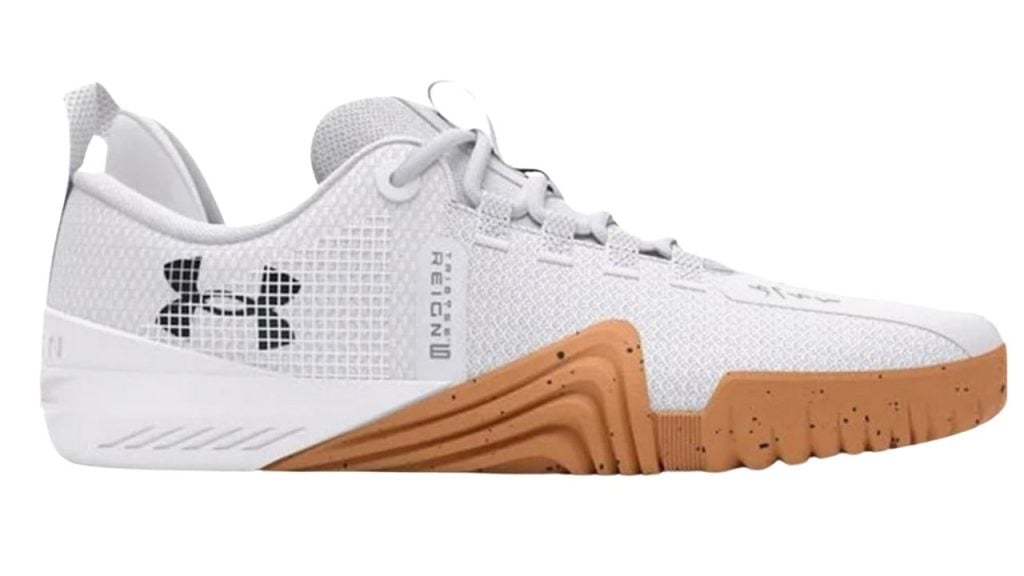
The TriBase Reign 6 surprised me. I didn’t expect much from Under Armour in this category, but these shoes ended up being one of my favorite options for functional strength sessions with a mix of bodyweight and weighted exercises. What stands out most is the stability — the base is wide and low to the ground, which makes everything from heavy goblet squats to lateral lunges feel secure. I’ve done ring work, plyometrics, and even sled pushes in these, and they hold up impressively well across the board.
Compared to the Nike Metcons or Reebok Nano X4s, the Reign 6 feels slightly more flexible in the forefoot, which I appreciated for exercises that require foot mobility — like deep squats, push-up transitions, or even agility drills. The upper is breathable yet durable, with a snug fit that doesn’t cause hot spots or heel slip. The outsole has great traction too — it grips well whether I’m training on rubber flooring, concrete, or wooden surfaces. It doesn’t quite have the barefoot-level ground feel of a minimalist shoe, but it offers a very controlled, close-to-ground experience for a shoe with some support and structure.
The only downsides for me are the styling (a bit more “generic gym shoe” than some of the others) and the fact that they’re a bit overbuilt for purely bodyweight training. But if you’re mixing pull-ups and dips with kettlebell snatches, banded squats, or barbell lifts, the Reign 6 delivers reliable support without being overly stiff or clunky. I’d call these one of the most underrated training shoes I’ve tested.
🔍 Fact Sheet
- Drop: 2mm (low and stable)
- Weight: ~310g (medium weight)
- Upper Material: Breathable engineered mesh with overlays
- Outsole: TriBase™ tech for full-ground contact and grip
- Heel: Low and stable for lifting
- Best Use: Strength training, calisthenics, hybrid sessions
✅ Pros
- Low to the ground with excellent lateral stability
- Strong grip on varied surfaces
- Breathable and secure upper
- Flexible enough for mixed training
- Underrated performance for hybrid workouts
❌ Cons
- Not as light or minimal as barefoot shoes
- Style is a bit plain and bulky
- Less suited for high-rep footwork or agility-focused drills
👉 Check customer reviews for UA Tribase and buy on Amazon
Feiyue — Minimal, Stylish, and Surprisingly Functional
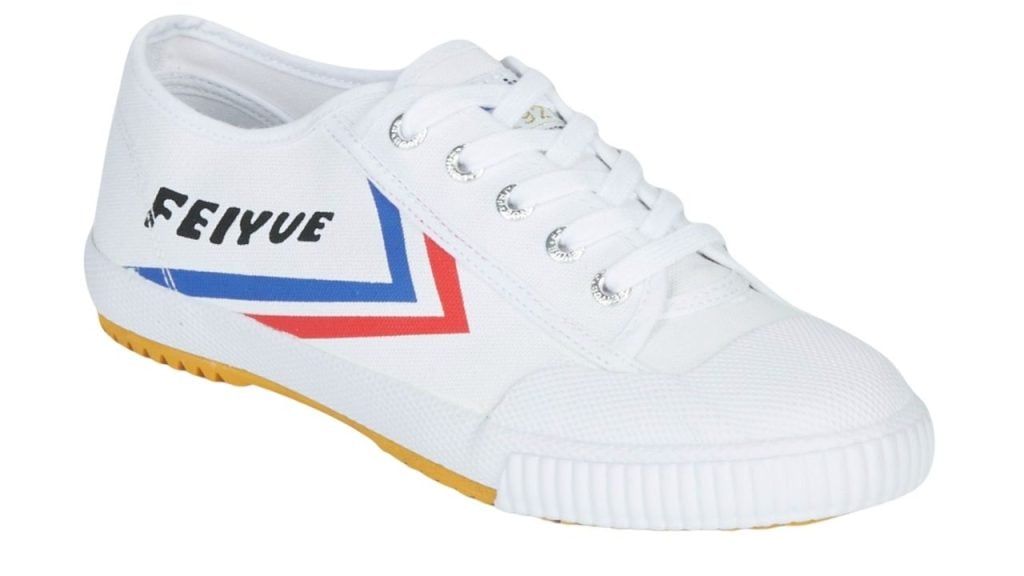
The Feiyue shoes are a bit of a cult classic in the martial arts world, but I decided to give them a go for calisthenics — and honestly, they’ve earned their place in my rotation. They’re super flat, low-profile, and lightweight, which ticks a lot of boxes for bodyweight training. There’s no modern tech here — just a simple rubber sole, canvas upper, and a classic design that somehow still works really well for things like squats, push-ups, handstands, and even jump rope.
What surprised me most is how stable these feel for such a simple shoe. The sole isn’t very cushioned, but it’s grippy and consistent, giving me good traction on both indoor and outdoor surfaces. The flexibility in the forefoot is also nice — I’ve found them really comfortable for deep squats and movements that require ankle mobility. Because they’re so minimal, I get great ground feel without the price tag of a dedicated barefoot trainer. They also look pretty clean for casual wear, which makes them a decent “train and walk around town” option.
That said, you definitely get what you pay for in terms of durability. The canvas upper can start to fray with heavy use, and the sole wears faster than more premium shoes like Vivobarefoot or Metcons. I wouldn’t trust them for any kind of heavy lifting, nor would I wear them for high-impact plyometrics. But if you want an inexpensive, minimalist shoe for calisthenics, skill work, or light outdoor training, Feiyues are a hidden gem — especially for the price.
🔍 Fact Sheet
- Drop: Zero drop
- Weight: ~250g
- Upper Material: Canvas
- Outsole: Flat rubber sole with herringbone grip
- Toe Box: Medium width
- Best Use: Bodyweight training, mobility, light outdoor workouts, casual wear
✅ Pros
- Extremely affordable minimalist option
- Lightweight and flexible
- Grippy rubber outsole for indoor/outdoor use
- Great for squats, handstands, and skill work
- Simple, clean aesthetic
❌ Cons
- Not very durable under high volume use
- Thin sole doesn’t offer much protection or support
- Upper can fray or stretch with time
- Lacks structure for loaded movements
👉 Check customer reviews for Feiyue and buy on Amazon
Converse Chuck Taylors — Old-School Lifting Icon with Street Style
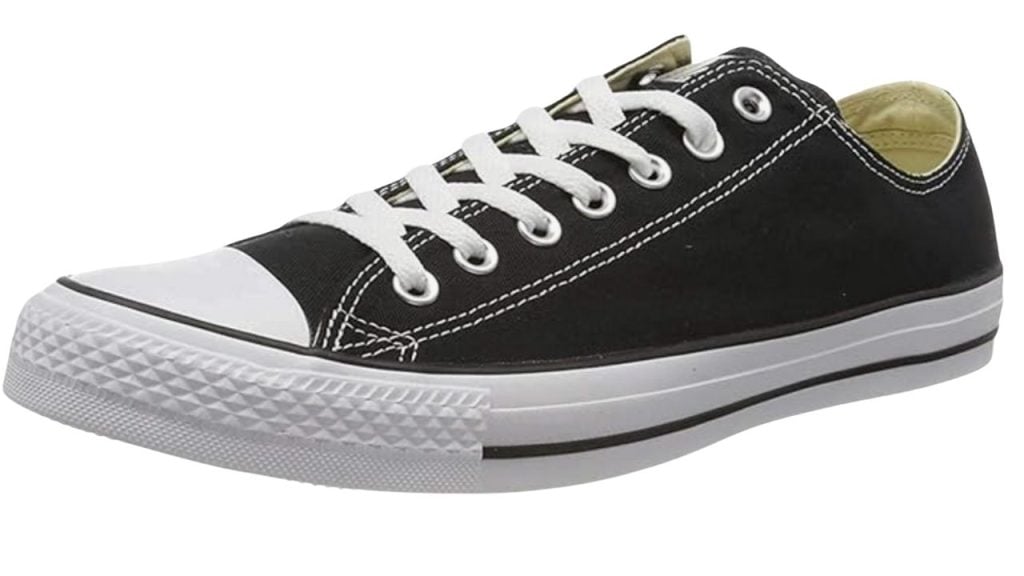
The Chuck Taylors are a classic — not originally designed for strength training, but they’ve become something of a cult favorite in lifting circles, and I get why. I’ve used them on and off for years, especially on leg days or when I want a no-frills, flat-bottom shoe for squats, deadlifts, or standing overhead presses. They offer a flat, stable base with zero drop, and the outsole grips well on gym floors and rubber mats. Plus, the high-top version gives a bit of ankle support if you’re into that retro vibe.
For calisthenics, they’re a bit of a mixed bag. I like them for static holds or low-movement sessions — things like ring dips, wall handstands, or planche training, where having a bit of heft isn’t an issue. But they’re noticeably heavier and bulkier than more modern minimalist shoes. If I’m doing fast-paced AMRAPs or high-volume circuits, I tend to reach for something lighter. The canvas upper also doesn’t breathe well, so my feet get sweaty faster in these, especially in the summer.
That said, Chucks are durable, budget-friendly, and incredibly versatile. You can wear them to the gym, to the park, or just casually — and they’ll fit right in. They’re not purpose-built for functional training, but they’ve earned a spot in my collection as a dependable, no-nonsense option that holds up well under load. Just don’t expect them to feel like a barefoot shoe — these are flat, but they’re not flexible or foot-shaped.
🔍 Fact Sheet
- Drop: Zero drop
- Weight: ~400g (depending on high-top vs low-top)
- Upper Material: Durable canvas
- Outsole: Flat rubber sole
- Toe Box: Narrow to medium (not foot-shaped)
- Best Use: Lifting, squats, basic calisthenics, casual wear
✅ Pros
- Flat, stable base great for squats and deadlifts
- Affordable and widely available
- Stylish enough for everyday wear
- Durable upper and outsole
- High-top version offers added ankle support
❌ Cons
- Heavier and bulkier than modern trainers
- Poor breathability (especially in warm weather)
- Narrow fit — not ideal for wider feet
- Lacks flexibility and ground feel for dynamic movement
👉 Check customer reviews for Chucks and buy on Amazon
Vans Sneakers — Flat Soles with a Surprising Gym Edge
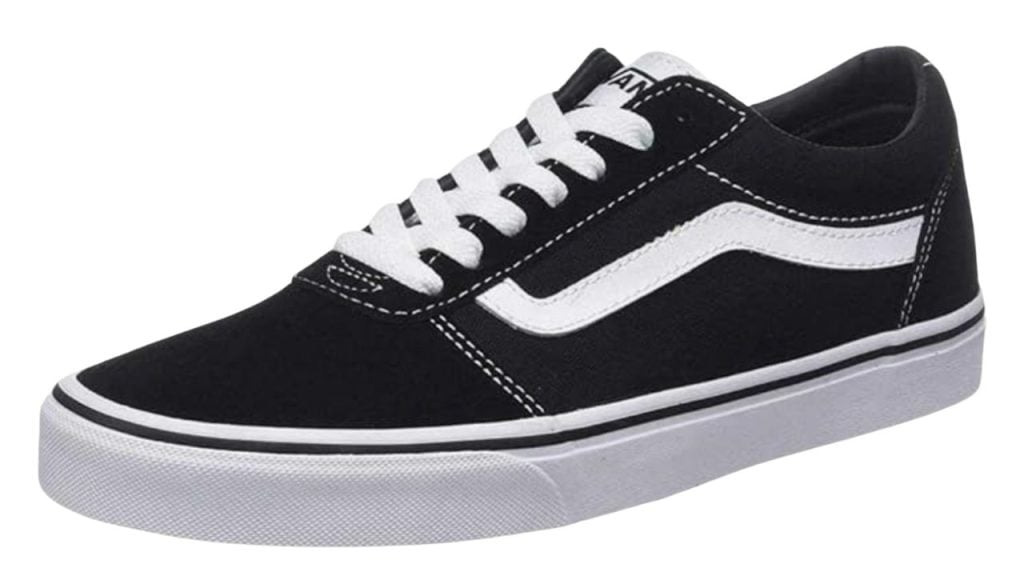
Vans weren’t designed for the gym, but like Chucks, they’ve earned a following among lifters and minimalist trainers — and after using them in my own workouts, I can see why. The flat rubber sole gives a stable base that works surprisingly well for exercises like deadlifts, bodyweight squats, and even push-up progressions. They’ve got a grippy waffle outsole that holds up nicely on both wooden and rubber gym floors, and the canvas upper gives just enough support to keep the foot secure without feeling restrictive.
In calisthenics sessions, I use Vans when I want a casual, wear-anywhere option that still lets me train with solid footing. They’re not performance shoes by any stretch, but they do fine for static strength work, skills practice, or slower circuit-style training. I wouldn’t choose them for high-intensity conditioning, plyos, or anything involving lots of jumping — the cushioning and flexibility just isn’t there. But for foundational bodyweight moves and some strength-focused work, they get the job done.
Where Vans really shine is in day-to-day versatility. I’ll wear them to the park, run errands, and squeeze in a session without changing footwear. Durability is solid too — the canvas upper can take some abuse, and the outsole doesn’t flatten easily under load. The fit is a bit snug if you have wider feet, and they don’t breathe super well, but for the price and style, they’re a reliable option for low-impact calisthenics.
🔍 Fact Sheet
- Drop: Zero drop
- Weight: ~350g
- Upper Material: Canvas or suede (depending on model)
- Outsole: Vulcanized rubber waffle pattern
- Toe Box: Medium-narrow
- Best Use: Static calisthenics, strength training, casual wear
✅ Pros
- Flat, stable sole great for squats and deadlifts
- Grippy outsole provides reliable traction
- Affordable and easy to find
- Durable canvas upper
- Versatile for training and everyday wear
❌ Cons
- Not ideal for high-impact or dynamic workouts
- Less breathable than modern athletic shoes
- Narrower fit not suited for wide feet
- Minimal flexibility and no performance features
👉 Check customer reviews for Vans and buy on Amazon
Conclusion: What’s the Best Shoe for Your Training Style?
After personally testing all of these shoes in my own calisthenics and functional strength training routines, I can confidently say that there is no one-size-fits-all answer — but there is a best shoe for your specific needs and goals.
If calisthenics is your main focus, and you care about ground feel, foot control, and natural movement, the Vivobarefoot Primus Lite 3 is hands-down the best. They’ve become my go-to for everything from skill work to mobility flows, and they’ve noticeably improved my foot strength and balance. If you want a more budget-friendly alternative, the Merrell Vapor Glove 6 or Feiyue are excellent minimalist options — just be mindful of durability.
If you’re combining calisthenics with weight training, like kettlebells, dumbbells, or barbell squats, you’ll probably want something with more structure and support. That’s where the Reebok Nano X4, Nike Metcon 9, and Under Armour TriBase Reign 6 really shine. Out of those three, the Metcon 9 feels the most solid under serious load, while the Nano X4 offers the best balance between comfort, breathability, and versatility. The Reign 6 surprised me the most — it’s an underrated performer that handles just about anything I throw at it.
For those who like a bit of old-school flair or want a shoe that doubles as a casual daily option, Converse Chucks and Vans are solid picks. They’re flat, grippy, and inexpensive, but not performance shoes. I wear them for static work or leg days when I don’t need flexibility or breathability.
And if you’re a purist — someone who’s passionate about building foot strength from the ground up — the Vibram FiveFingers are a niche but powerful tool. They’re not for everyone, but when it comes to foot articulation and barefoot precision, they’re unmatched.
| Best For… | My Pick |
|---|---|
| Pure Calisthenics / Barefoot Training | Vivobarefoot Primus Lite 3 |
| Hybrid Strength + Calisthenics | Reebok Nano X4 or Nike Metcon 9 |
| Budget Barefoot Option | Merrell Vapor Glove 6 or Feiyue |
| Static Lifting on a Budget | Converse Chuck Taylors or Vans Sneakers |
| Foot Strength & Mobility Purists | Vibram FiveFingers |
| Underrated Hybrid Performer | UA TriBase Reign 6 |
Final Tip
If you’re serious about your training, it’s worth having more than one pair to match the type of session you’re doing. I rotate between minimalist shoes like the Primus Lite for skill work, and the Metcon or Nano for heavy leg days. Your feet will thank you — and so will your performance.
👉 If you’re curious about customer feedback or want to dig into sizing and specs, I’ve included links to each shoe’s Amazon page throughout this post so you can check out the latest reviews and offers.
Happy training — and let your feet move the way they’re meant to.

